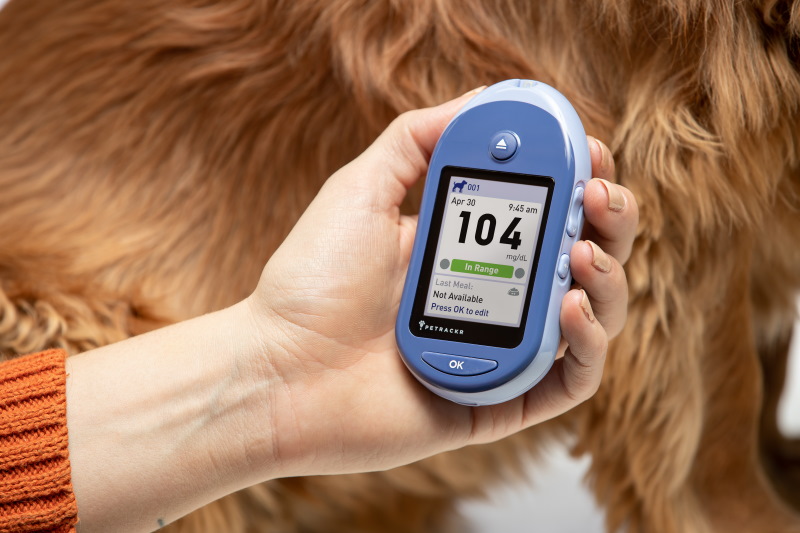Written & Reviewed by an approved Veterinary Medical Writer

Monitoring blood glucose levels in cats and dogs with diabetes is crucial to ensure their overall health and well-being. Diabetes in pets, just like in humans, can lead to significant complications if not managed properly.
Regular blood glucose monitoring allows pet owners and veterinarians to closely track any shifts in glucose levels, enabling them to make timely adjustments to medication, diet, and lifestyle. By maintaining stable blood glucose levels, the risk of immediate complications such as hypoglycemia or hyperglycemia can be minimised, preventing potential emergencies.
Furthermore, consistent monitoring helps detect trends and patterns, aiding veterinarians in tailoring treatment plans to the individual needs of each pet. This proactive approach not only enhances the quality of life for pets with diabetes but also contributes to extending their lifespan and reducing the risk of secondary health issues that can arise from poorly controlled blood sugar levels.
How often should I monitor the blood glucose levels of my pets if they have diabetes?
If your pet has diabetes, it is important to monitor their blood glucose levels on a daily basis. This is for several reasons;
- Optimal Glucose Regulation: Daily monitoring allows you to make timely adjustments to insulin dosage, diet, and exercise to keep your pet’s blood sugar levels within a target range.
- Personalising Your Pet’s Treatment Plan: Daily monitoring helps you and your veterinarian create a treatment plan tailored to your pet’s specific needs, ensuring that they receive the right insulin dosage, diet, and exercise regimen for optimal health.
- Early Detection (and Prevention): Monitoring daily allows you to identify trends over time. By responding to these trends early, you can help your pet avoid potential health complications, such as organ damage or infections.
- Quality of Life: Well-managed diabetes contributes to a better quality of life for your pet. Stable blood sugar levels can prevent symptoms such as excessive thirst, frequent urination, lethargy, and weight loss, allowing your pet to lead a more comfortable and active life.
What are the risks of inadequate blood glucose monitoring?
Inadequate blood glucose monitoring in pets, particularly those with diabetes, poses serious risks. Fluctuations in blood sugar levels can lead to complications like hypoglycemia or hyperglycemia.
Hypoglycemia, characterised by low blood sugar, can result in seizures, weakness, and even coma. Conversely, hyperglycemia, high blood sugar, can lead to lethargy, increased thirst, and organ damage over time.
Without proper monitoring, adjustments to insulin doses and dietary management become challenging, putting the pet’s health in jeopardy. Regular blood glucose checks are essential to prevent these life-threatening conditions and ensure a better quality of life for diabetic pets.
What are the benefits of daily blood glucose monitoring in pets?
Daily blood glucose monitoring in pets allows pet owners to effectively manage conditions like diabetes, ensuring timely adjustments to insulin doses and diet. Additionally, monitoring trends in glucose levels helps prevent dangerous fluctuations, reducing the risk of hypoglycemia or hyperglycemia.
Early detection of abnormalities enables timely veterinary intervention, preventing complications and enhancing the pet’s quality of life. Additionally, regular monitoring fosters a stronger bond between pet and owner, as it demonstrates care and commitment to the pet’s well-being.
How can I monitor the blood glucose of my pets?
Pet owners now have access to new technology with the PETRACKR glucose monitoring strips, an accurate and efficient solution for tracking pets’ blood glucose levels. These strips stand out by delivering laboratory analyser-level precision.
With rapid results obtained from a small sample size within seconds, they ensure timely insights into pets’ health. The design prioritises safety, featuring a sample disposal eject button. Easy data collection and management are facilitated, while the accompanying smartphone app offers customisable pet profiles.
An additional advantage is the no-coding feature; the strips are auto-calibrated for both cats and dogs, making it easy for pet owners and veterinarians.
With PETRACKR, managing pets’ diabetes becomes seamless and reliable.
What are some tips for pet owners on blood glucose monitoring?
- Firstly, consult a veterinarian for guidance on testing frequency and technique. Acquire a reliable glucose meter designed for your pet’s species.
- Familiarise yourself with the testing process by observing your vet. Keep a record of readings to identify trends.
- Perform tests consistently at the same time and under similar conditions. Reward your pet after testing to create a positive association.
- Ensure clean paws for accurate results.
- If levels are consistently off, consult the vet to adjust the treatment plan.
FAQs (Frequently Asked Questions)
How often should I take my pet to the vet for diabetes check-ups?
For pets diagnosed with diabetes, regular veterinary check-ups are crucial to manage their condition effectively.
Typically, diabetic pets require check-ups every 2 to 4 months, especially during the initial stages of treatment to ensure proper insulin regulation and monitor their overall health. These appointments enable the vet to adjust medication, evaluate blood sugar levels, and assess any complications or changes in behaviour.
However, the frequency might vary based on your pet’s individual needs and the vet’s recommendations. Open communication with your vet is essential for devising a tailored check-up schedule that ensures your furry friend’s well-being and quality of life.
What should I do if my pet’s blood glucose readings are consistently too high or too low?
If your pet’s blood glucose readings are consistently too high or too low, it’s crucial to take immediate action.
High readings might indicate diabetes and require dietary adjustments, insulin administration, and regular vet check-ups. Low readings could signal hypoglycemia, necessitating fast-acting glucose sources like honey or specialised gels.
Consult your veterinarian for guidance on adjusting medication doses, modifying the diet, and establishing a proper monitoring routine. Consistent communication with your vet is essential to manage your pet’s blood glucose levels effectively and ensure their overall well-being.
Are there signs I should watch for even if I’m monitoring daily?
Even with daily monitoring, certain signs deserve heightened attention. Look for abrupt deviations from the established patterns or trends. Sudden spikes or drops in metrics might indicate anomalies.
Additionally, be alert to unusual correlations or discrepancies that defy logical explanations. Changes that occur consistently at certain times could signal external factors influencing the situation.
Remember to assess both quantitative data and qualitative observations. Human intuition can sometimes highlight subtle shifts that data alone might miss. Regularly reevaluate your monitoring strategy to ensure it remains aligned with the most relevant indicators for accurate early detection.
Sources
https://www.collaroyvet.com.au/diabetes-in-cats-dogs/
https://www.aaha.org/aaha-guidelines/diabetes-management/monitoring/
https://www.avma.org/resources/pet-owners/petcare/diabetes-pets
https://diabetes-m.com/blog/tips-tricks/caring-for-your-diabetic-pet/
